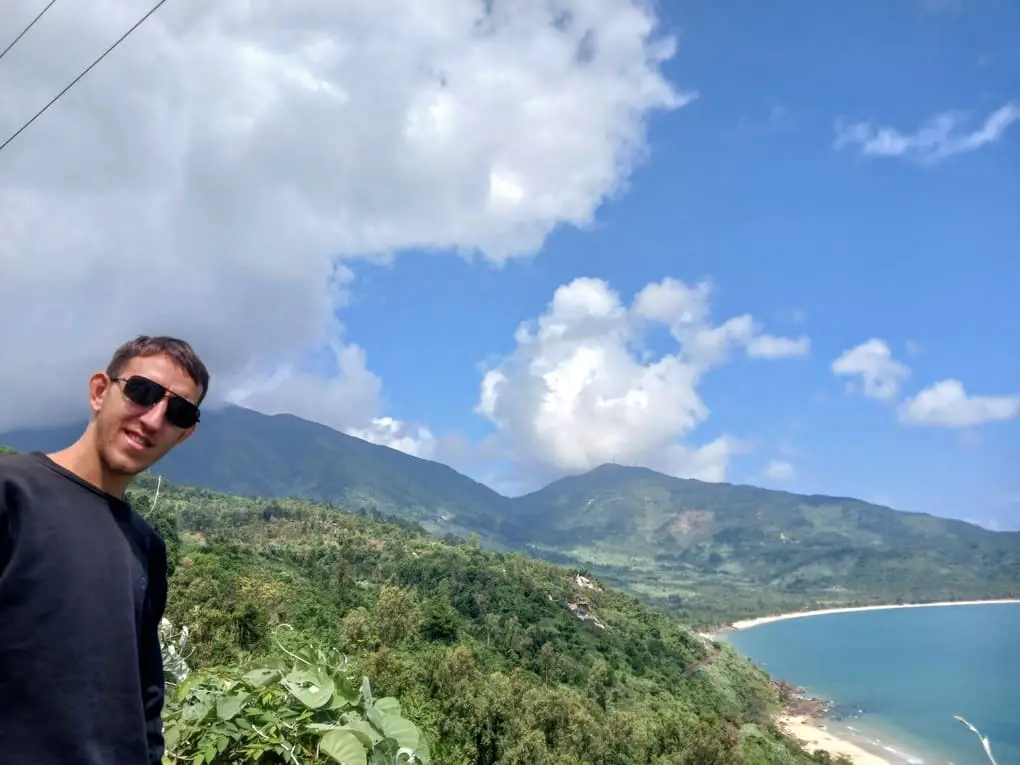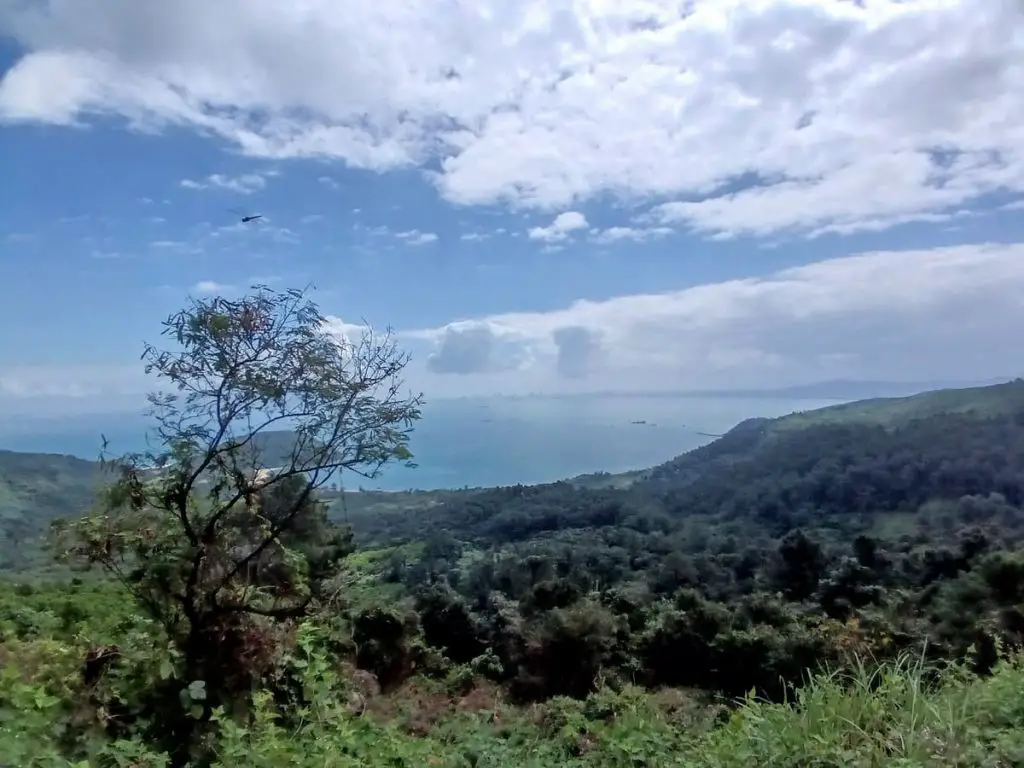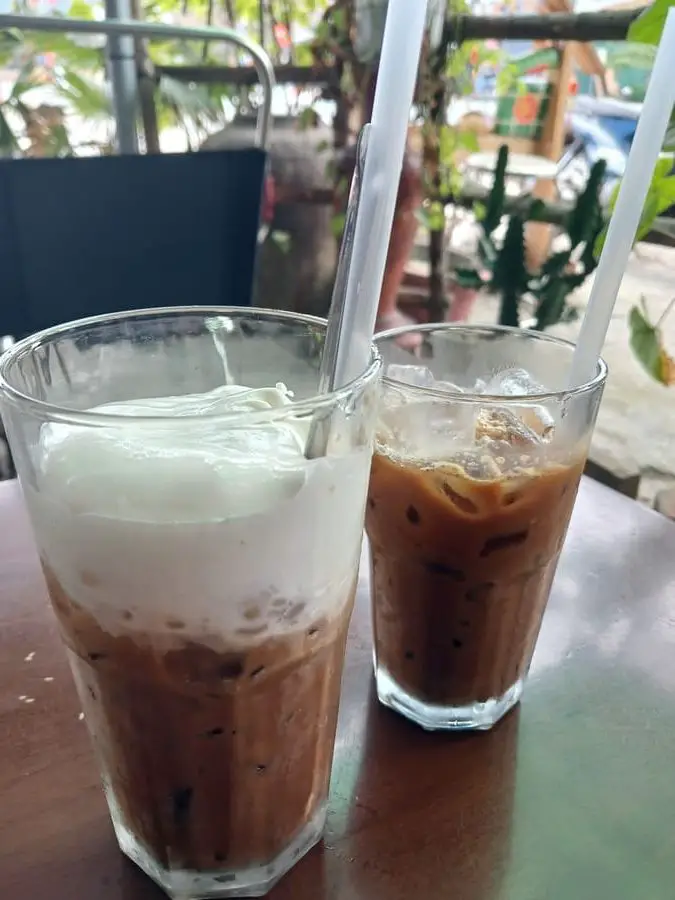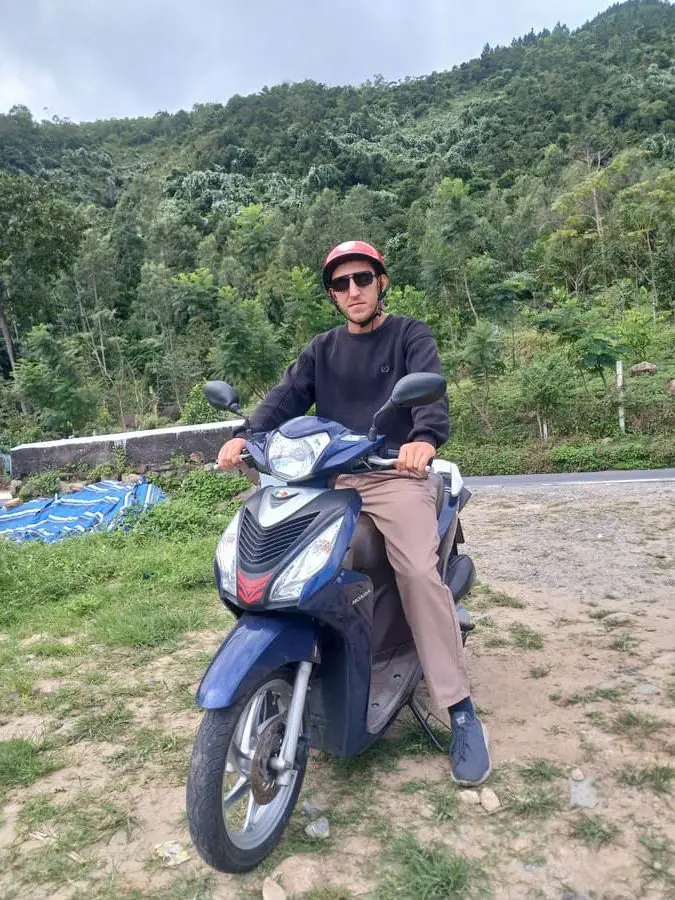Hai Van Pass on a Motorcycle: The Full Guide
This post may contain affiliate links. If you make a purchase using one of these links, I may receive a small reward at no extra cost to you. See my Disclosure Policy for more information.
Where does South Vietnam end and North Vietnam begin? Politically, it’s the 17th parallel, a bit north of Hue, where the country was divided until 1975.
Climate-wise though, it is the Hai Van Pass, a 20-kilometer-long mountain pass just 30 minutes north of Da Nang. Would you believe that in winter months north of it is wet and cold while the southern side remains warm and pleasant?
The impressive scenery along the way with views of the coastline, Da Nang Bay, and lush green mountains make the Hai Van Pass awesome.

It’s best done driving a motorcycle either as a day trip from Da Nang or as a more exciting way to get from Hoi An to Hue. Here’s all you need to know about the Hai Van Pass on a motorcycle!
Hai Van Pass Quick Facts
- Distance from Da Nang to Hue: ~100 km
- Distance from Hoi An to Hue: ~130 km
- Length of Hai Van Pass: ~20 km
- Duration: 1 day or just a few hours
- Best Time: March to August
- Attractions: vistas, beaches, waterfalls, historic gates, bunkers
- Road Conditions: Pretty good, low to moderate traffic
- Difficulty: 2/5. Beginner-friendly
One-way or a Day trip?
Most backpackers rent a motorcycle in Hue, Da Nang, or Hoi An and drive the 100-130 km between the cities through the 20 km Hai Van Pass. They then return the motorcycle at their destination. Plenty of motorcycle rentals offer this option which is perfect if you don’t plan to return.
Others rent a motorcycle in Da Nang (or Hoi An), drive over the Hai Van Pass until reaching Lang Co (sometimes spelled An Cu), and then drive back the same day. It’s an easy way to experience the most exciting part of the road. Twice!

The rest of the road (Lang Co to Hue and Hoi An to Da Nang) is not picturesque or memorable in any significant way, so when doing the Hai Van Pass as a day trip, you won’t miss out much. This is what I did.
One-Way Hai Van Pass
If you could choose which way to ride on the Hai Van Pass, choose south to north, i.e. Da Nang to Hue. You’ll be on the right side of the road, the one with the awesome views. Moreover, you can spend 3 days in Hoi An before journeying north.
But you probably can’t choose. You’ve already made plans and are traveling through Vietnam. Regardless of which city you’re in – Da Nang, Hue, or Hoi An, you have to find a motorcycle rental that allows you to return the bike on the other side of the pass.
Thankfully, pretty much any rental place, hostel, or hotel offers such a deal. A few recommended names:
- In Hoi An – Style Motorbikes
- In Da Nang – Tigit Motorbikes
- In Hue – Kenvin Motorbike
One-way rental is usually more expensive than the regular same-place return. Expect to pay 220.000 to 250.000 VND (9-10 USD).
Luggage Transfer (for one-way travel)
Chances are you also have a big backpack, something too large to put on the side of the motorbike or your back while driving.
Once again, most rental places have you covered. For a measly 40.000 to 50.000 VND (1.6-2 USD) per day, you will get your luggage transferred and kept safe at the place where you’ll return the motorbike.
Hai Van Pass as Day Trip from Da Nang
Riding the Hai Van Pass from Da Nang is cheaper, easier and you get to do it twice!
Simply rent a scooter or a motorcycle for a day and follow the coastal road until it starts climbing up. Voila, you’re driving the Hai Van Pass.
Once you go to the other side, decide how much further you want to go, then go back. Hai Van Pass officially ends just before Lang Co town, so it’s a logical end stop. With the alternative road adding upwards of 100 km, it’s not feasible to do a loop (what’s called The Golden Loop).

One-day scooter rental in Da Nang goes for 120.000 VND (5$), while a semi-automatic bike costs just 100.000 VND (4$).
What to expect while driving on the Hai Van Pass
Let’s get you ready with some useful practicalities and logistical tips.
Traffic
Since the completion of the Hai Van Tunnel in 2005, the traffic on the Hai Van Pass has gotten low and pleasant.
Most of the vehicles are motorcycles (it’s Vietnam after all), fuel tankers (not allowed in the tunnel), and the occasional car with sightseers that don’t mind the additional 20 km and numerous hairpin bends.
The biggest annoyance is the fuel tankers that go at 20-30 km/h. If you get stuck behind one and have no visibility to overtake, it’s best to stop for 5 minutes, take a few pictures, then continue and hope you catch up to the tanker in a better spot.
Stopping for pictures, cafe, food
There are dozens of good stops for pictures. With a motorcycle, you can stop on the side of the road as long as there is at least a little bit of space to the right of the white line. At least 10 popular spots exist with a small impromptu parking.

There are also a few cafes on the way: I counted 6 before the Hải Vân Quan Gate at the top and 10 or so stalls at the top.
Most of the cafes also serve some food. There are a few restaurants too. Prices are, of course, much higher than down in the city, so unless you’re starving, wait until you reach Lang Co/Da Nang to save some money.
Fuel
There are no gas stations on the Hai Van Pass itself (i.e. the 20 km mountain pass). There are gas stations on both ends though.
Since the pass is quite short, you don’t need to stock up on too much fuel but don’t risk it going up on your last dash.
Weather
The dry season in and around Da Nang is between January and August. Avoid the Hai Van Pass during the rainy season – you won’t have a good time driving a motorcycle in the pouring rain.

Of the dry months, January and early February may be a bit cold but bearable. This makes the period from March to August the best time to visit the Hai Van Pass.
As for the weather during the day – check the forecast and keep in mind that it may change suddenly but don’t be too worried in the dry months. When I went in mid-February, the forecast predicted light rain but all I got was a few dark clouds.
My Experience Driving the Hai Van Pass
I did the pass as a day tour from Da Nang. I could rent a motorcycle directly from my hotel (many hotels in Da Nang offer rentals but if yours don’t, there will be a rental around the corner, trust me) and I was on the road by 10:00 AM.

I stopped for a quick 15-minute breakfast on the Da Nang Bay beach. At 11:10 I was at the foot of the Hai Van Pass.
I stopped for pictures a couple of times along the way. I was at the top next to the Hải Vân Quan Gate at 11:40 to explore the bunkers the French left.

I did the short off-the-beaten-track detour that goes down almost to the beaches (there is a trail to get down on foot) and back to the main road by 12:45.
I got down to Lang Co at 13:00, had lunch at one of the roadside restaurants, a marvelous coffee from Coffee Alavy (seriously, it was so good!), checked out the beach, and was back on the road by 14:30.

It took me another 90 minutes to get back to my hotel in Da Nang. All in all, a day trip to the Hai Van Pass and back from Da Nang took me around 6 hours.
Detour to the Hidden Beach
Less than a kilometer down from the top of the pass, you will see a fork: the main road sharply turns to the left and a small paved road goes to the right.
I expected a bad offroad experience but was pleasantly surprised – the road is in almost perfect condition and continues for 7 km until ending suddenly into the jungle.

From there, a trail continues down for about 1 km until reaching the hidden Banana Beach.
Very few use this road and it makes for a pleasant slow ride with nice views.
Easyrider
An “Easyrider” is when you hire someone to take you on their motorcycle. You will be riding on the pillion seat behind the driver.
This option is for those not confident enough to drive alone or worried about not having the proper documents to drive a motorcycle in Vietnam.
Renting a Motorcycle
Renting a motorcycle anywhere in Vietnam is easier than finding chocolate spread. Seriously, there is no Nutella anywhere, but a motorcycle rental shop at every corner.

What bike to rent?
Unlike the Ha Giang Loop, the Hai Van Pass is quite easy, with slopes no steeper than a 10% gradient. This means that even a simple scooter will do the job.
Most scooters in Vietnam are 110 cc or more, i.e. enough power to climb the Pass.
A semi-automatic is still the better option – often cheaper, allows better control, and generally sturdier.
Check the motorcycle before you go!
I would think that goes without saying but many are eager to hop on their rented scooter as soon as handing out the cash.
Patience, young padawan.
- Inspect the bike for scratches (take a video going around it)
- Take a quick look at the tires and make sure they still have their tread pattern.
- Check the brakes to make sure they are hard enough
- Check how much fuel the bike has
- Test the honk & lights
- Open the trunk
- Ask for a helmet
License
You will be driving legally in Vietnam if and only if:
- You have a Category A motorcycle license. A1 is okay if your bike is <125 cc. AM is not enough – it’s only for motorcycles reaching speeds under 45 km/h
AND
- You have an International Drivers Permit (IDP) from a country that’s signed the 1968 Vienna Convention on Road Traffic. Vietnam hasn’t signed the 1949 one, so it’s not valid there.
OR
- You have a Vietnamese Driving License
Many drive illegally in Vietnam. The problem is not so much the authorities, as your insurance. You are NOT properly insured if you drive illegally and your insurer will certainly not cover the bill for any accidents.
I use SafetyWing for personal health insurance while traveling. It will cover your medical expenses should anything happen while driving as long as you have the proper documents and wear a helmet.
Police Checks on the Hai Van Pass
Some Easyrider places may try to scare you into thinking that there’s always police on the Pass so you use their services.
In reality, there is seldom any police on the Hai Van Pass. There may be police checkpoints at the exits of Da Nang though.
If the police stop you and you’re not driving legally (check above), it’s usually just a fine/bribe of 200.000 to 1.000.000 VND (8-41$).
Other ways to do the Hai Van Pass
Going over the Pass on a motorcycle is the best. It allows you to stop when and where you want and to feel the fresh air in your hair. But it’s not the only way.
By Jeep
It has to be the second-best option. You’ll be riding in a US-Army-style Jeep with an open roof and no windows. It’s kind of cool actually, although you’ll have to dish out an extra million dong for the pleasure.
Check out this Jeep Tour with a pick-up in either Hue, Da Nang, or Hoi An.
By Car
You can stop at fewer places, no wind in the hair and it’s more expensive to rent a car (maybe more complicated too).
You can hire a driver or check out this sightseeing private transfer option.
By Bicycle
I saw a few cyclists on the Hai Van Pass and although they looked like they were having a lot of fun, it probably had to do with them going downhill at the time.
This is only for very fit cyclists with good bikes.
By Train
The train tracks do not go parallel to the main road of the Hai Van Pass, but quite a bit lower. The views, I’ve heard, are beautiful, but there’s no way they compare to the wide vistas you see from above.
Towards the end of the pass (closer to Lang Co), the road crosses the train tracks and if you’re lucky (or check the times beforehand) you may see a train pass.
By Bus
Nah. Public transport buses and all other tourist buses use the tunnel under the mountain (the longest tunnel in all of Southeast Asia!) and you won’t see a thing.


